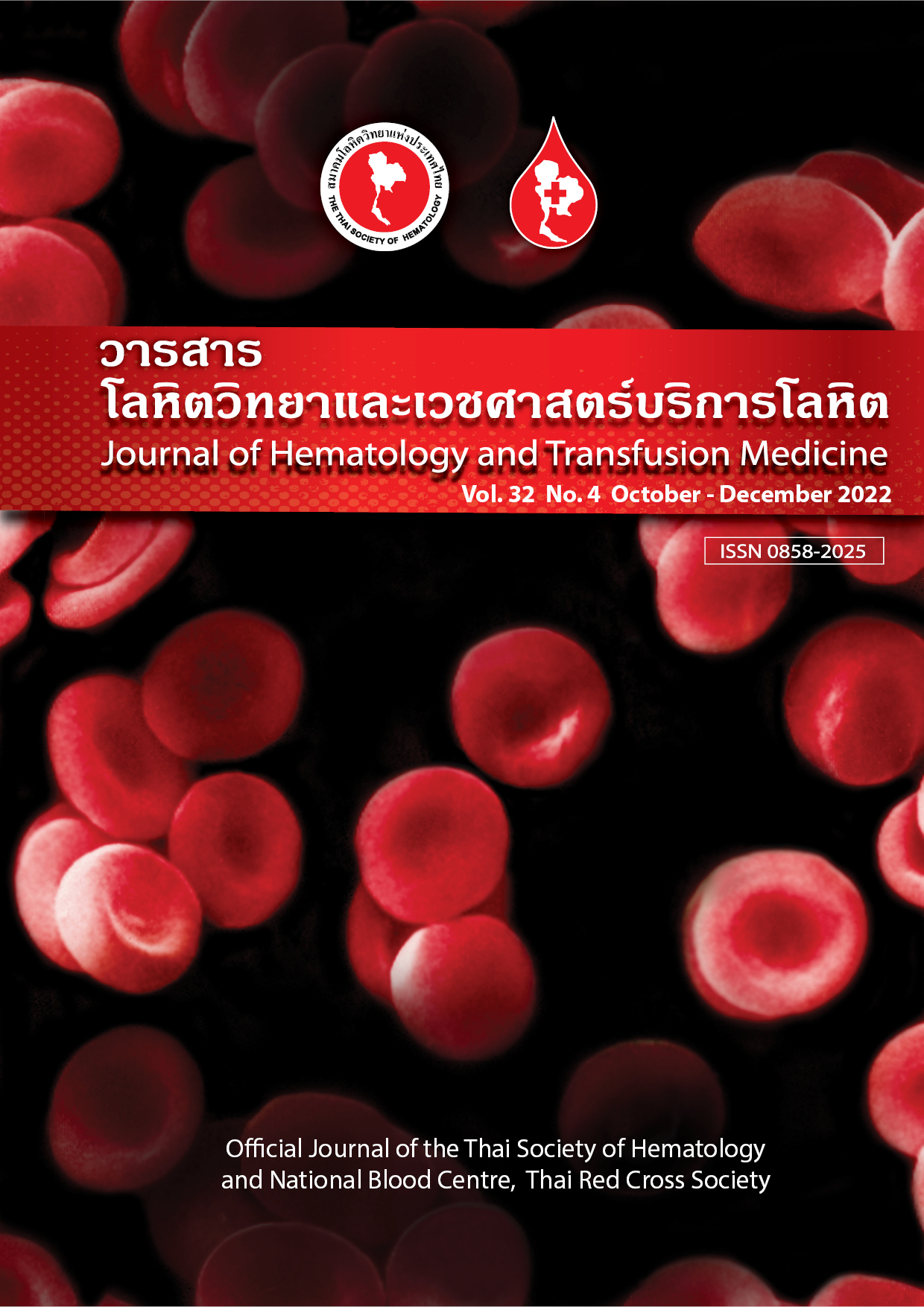ความชุกและปัจจัยที่มีผลต่อการเกิดภาวะโลหิตจางจากการขาดธาตุเหล็กในนิสิตแพทย์หญิง
คำสำคัญ:
ความชุก, การขาดธาตุเหล็ก, โรคโลหิตจางจากการขาดธาตุเหล็ก, นักศึกษาแพทย์บทคัดย่อ
วัตถุประสงค์ เพื่อศึกษาความชุกและปัจจัยที่เกี่ยวขอ้ งของภาวะโลหิตจางจากการขาดธาตุเหล็กในนิสิตแพทย์หญิงไทย วัสดุและวิธีการ นิสิตแพทย์หญิงไทยอายุ 20-25 ปี ตั้งแต่มิถุนายน พศ. 2562 ถึง กุมภาพันธ์ พศ. 2564 โดยเก็บข้อมูลพื้นฐานทางคลินิก พฤติกรรม
การบริโภคอาหาร ประวัติประจำเดือน การบริจาคเลือดและการเสริมธาตุเหล็ก เก็บตัวอย่างเลือดดูความสมบูรณ์ของเม็ดเลือดและระดับเฟอร์ริติน ผลการวิจัย นิสิตแพทย์หญิงไทยจำนวน 128 คน มีระดับฮีโมโกลบินเฉลี่ย 12.6±0.928 กรัมต่อเดซิลิตร มีความชุกของโลหิตจางร้อยละ 14.1 โดยมีสาเหตุจากขาดธาตุเหล็กร้อยละ 7.8 และสาเหตุอื่นๆ ร้อยละ 6.2 ความชุกของการขาดธาตุเหล็กแต่ไม่มีภาวะโลหิตจางร้อยละ 3.9 ไม่พบปัจจัยที่เกี่ยวข้องที่มีนัยสำคัญทางสถิติในการศึกษานี้ สรุป ความชุกของภาวะโลหิตจางจากขาดธาตุเหล็กในนิสิตแพทย์หญิงไทยอยู่ในระดับต่ำแต่เป็นสาเหตุที่พบบ่อยที่สุดของภาวะโลหิตจาง และมีบางรายมีภาวะโลหิตจางรุนแรงในระดับปานกลาง ดังนั้น ควรมีการใหค้ วามรู ้ ส่งเสริมสุขภาพและตรวจคัดกรอง เพื่อป้องกันและให้การวินิจฉัยภาวะโลหิตจางจากการขาดธาตุเหล็ก
Downloads
เอกสารอ้างอิง
Camaschella C. Iron-deficiency anemia. N Engl J Med. 2015;372:1832-43.
Heath AL, Skeaff CM, Williams S, Gibson RS. The role of blood loss and diet in the aetiology of mild iron deficiency in premenopausal
adult New Zealand women. Public health nutrition.2001;4:197-206.
Worthington-Roberts BS, Breskin MW, Monsen ER. Iron status of premenopausal women in a university community and its relationship to habitual dietary sources of protein. Am J Clin Nutr. 1988;47:275-9.
Ball MJ, Bartlett MA. Dietary intake and iron status of Australian vegetarian women. Am J Clin Nutr. 1999;70:353-8.
Shill KB, Karmakar P, Kibria MG, Das A, Rahman MA, Hossain MS, et al. Prevalence of iron-deficiency anaemia among university students in Noakhali region, Bangladesh. J Health Popul Nutr. 2014;32:103-10.
Abalkhail B, Shawky S. Prevalence of daily breakfast intake, iron deficiency anaemia and awareness of being anaemic among Saudi school students. Int J Food Sci Nutr. 2002;53:519-28.
Ganasegeran K, Al-Dubai SA, Qureshi AM, Al-abed AA, Am R, Aljunid SM. Social and psychological factors affecting eating habits among university students in a Malaysian medical school: a cross-sectional study. Nutr J. 2012;11:48.
Ekpanyaskul C, Sithisarankul P, Wattanasirichaigoon S. Overweight/Obesity and related factors among Thai medical students. Asia-Pacific journal of public health. 2013;25:170-80.
Vibhute NA, Shah U, Belgaumi U, Kadashetti V, Bommanavar S, Kamate W. Prevalence and awareness of nutritional anemia among female medical students in Karad, Maharashtra, India: across-sectional study. J Family Med Prim Care. 2019;8:2369-72.
Kongsomboon K. Psychological problems and overweight in medical students compared to students from Faculty of Humanities, Srinakharinwirot University, Thailand. J Med Assoc Thai.2010;93(Suppl 2):S106-13.
Shams S, Asheri H, Kianmehr A, Ziaee V, Koochakzadeh L, Monajemzadeh M, et al. The prevalence of iron deficiency anaemia in female medical students in Tehran. Singapore Med J.2010;51:116-9.
Kannan B, Ivan EA. Prevalence of anemia among female medical students and its correlation with menstrual abnormalities and nutritional habits. International Journal of Reproduction, Contraception, Obstetrics and Gynecology. 2017;6(6).
Jawed S, Tariq S, Tariq S, Kamal A. Frequency of nutritional anemia among female medical students of Faisalabad. Pakistan Journal of Medical Sciences. 2017;33(2).
Al-alimi AA, Bashanfer S, Morish MA. Prevalence of Iron Deficiency Anemia among University Students in Hodeida Province, Yemen. Anemia. 2018;2018:1-7.
Al Hassan NN. The prevalence of iron deficiency anemia in Saudi University female students. J Microsc Ultrastruct. 2015;3:25-8.
Alzaheb RA, Al-Amer O. The Prevalence of Iron Deficiency Anemia and its Associated Risk Factors Among a Sample of Female University Students in Tabuk, Saudi Arabia. Clin Med Insights Womens Health. 2017;10:1179562X17745088.
Institute of Nutrition MU. INMUCAL-Nutrients V.4.0 2019 [Available from: https://inmu2.mahidol.ac.th/inmucal/.
World Health O. Serum ferritin concentrations for the assessment of iron status in individuals and populations: technical brief.
Geneva: World Health Organization; 2020 2020.
Sweet MG, Schmidt-Dalton Ta Fau - Weiss PM, Weiss Pm Fau-Madsen KP, Madsen KP. Evaluation and management of abnormal
uterine bleeding in premenopausal women. (1532-0650 (Electronic)).
AlSheikh M. Prevalence and risk factors of iron-deficiency anemia in Saudi female medical students. Saudi Journal for Health Sciences. 2018;7(3).
Safiri SA-O, Kolahi AA, Noori M, Nejadghaderi SA, Karamzad N, Bragazzi NL, et al. Burden of anemia and its underlying causes in 204 countries and territories, 1990-2019: results from the Global Burden of Disease Study 2019. (1756-8722 (Electronic)).
Jalambo MO, Karim NA, Naser IA, Sharif R. Prevalence and risk factor analysis of iron deficiency and iron-deficiency anaemia among female adolescents in the Gaza Strip, Palestine. Public health nutrition. 2018;21:2793-802.
Meng SH, Zhou HB, Li X, Wang MX, Kang LX, Fu JM, et al. Association Between Dietary Iron Intake and Serum Ferritin and Severe Headache or Migraine. Front Nutr. 2021;8:685564.
Timmer TC, de Groot R, Rijnhart JJM, Lakerveld J, Brug J, Perenboom CWM, et al. Dietary intake of heme iron is associated with ferritin and hemoglobin levels in Dutch blood donors: results from Donor InSight. Haematologica. 2020;105:2400-6.
ดาวน์โหลด
เผยแพร่แล้ว
ฉบับ
ประเภทบทความ
สัญญาอนุญาต
ลิขสิทธิ์ (c) 2022 วารสารโลหิตวิทยาและเวชศาสตร์บริการโลหิต

อนุญาตภายใต้เงื่อนไข Creative Commons Attribution-NonCommercial-NoDerivatives 4.0 International License.



